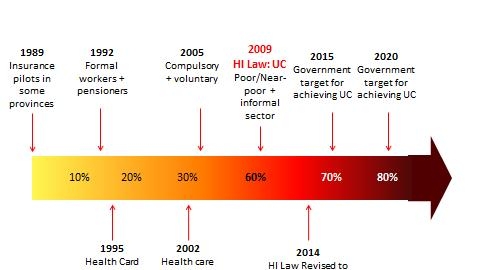Challenges
- Enrollment rates remain low even amongst those enrollment is compulsory, such as the formal sector, and despite large increases in the partial subsidy extended to the near-poor.
- In 2010, when nearly 60% of the population was already enrolled, their out-of-pocket (OOP) share in health expenses was still almost 60%. High OOP payments leave households exposed to financial risk.
Road map of reforms
- Expanding the breadth of coverage:
• Substantially increase general revenue financing to subsidize enrollment for the near poor and/or informal sector;
• Enhance information, education and communication about health insurance to both providers and beneficiaries;
• Encourage family enrollment; and
• Enforce enrollment compliance in the mandatory enrollment group, particularly formal sector workers.
- Improving equity and financial protection
• Strengthen implementation of the co-payment policy, including grievance mechanisms;
• Further reduce or waive co-payments for the poor and vulnerable groups such as ethnic minorities; and
• Introduce catastrophic cost coverage.
- Strengthening health financing arrangements for Social Health Insurance (SHI)
• Generate additional revenues by raising tobacco taxes and gradually increasing the premium contribution rate;
• Rationalize and cost out the benefits package;
• Reduce inefficiencies arising from the current mix of provider payment mechanisms; and
• De-fragment the procurement of and payment for pharmaceuticals.
- Strengthening Organization, Management and Governance of SHI
• Define the objectives of UC more clearly, and revise and define the roles and mandates of key agencies;
• Strengthen the organization of SHI by putting in place a specialized SHI Division and eventually SHI Agency;
• Strengthen SHI management arrangements
• Strengthen SHI governance and accountability by clearly specifying financial accounting arrangements, conflict resolution arrangements and penalties.
